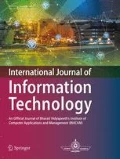Abstract
The group key exchange protocol is a cryptographic mechanism is designed to provide a common session key for a group, there are some common challenges to this type of algorithm as computation and communication cost. Whenever the involvement of high computation and communication operations to the algorithms encounter, then the system with low configuration always faces problem in major time delay. The proposed approach is designed specifically to provide computation and communication efficient algorithms for low configuration systems without violating the security. For making our approach computationally efficient, we replaced modular exponential operation by modular multiplication operation, helpful for low configuration system making task early. For making our approach communication efficient, we used the divide and conquer mechanism to reduced the message transmission cost. The major task is to generate a common session key for the group in less computation time for a low configuration system without violating the security. The RSA algorithm assuring security with constant computation cost while the modular multiplication operation, assuring the less computation cost for low configuration system. The major limitation of the study as the approach is more efficient and applicable for low configuration system only, if comparing the existing approaches with the low configuration system.


Similar content being viewed by others
References
Colin B, Anish M (2013) Protocols for authentication and key establishment. Springer Science and Business Media, Berlin
Forouzan BA, Debdeep M (2011) Cryptography and network security (Sie). McGraw-Hill Education, New York
Diffie W, Hellman M (1976) New directions in cryptography. IEEE Trans Inf Theory 22(6):644–654
Rawat AS, Deshmukh M (2019) Efficient extended Diffie–Hellman key exchange protocol. In: 2019 international conference on computing. Power and communication technologies (GUCON). IEEE, p 2019
Mandal S, Mohanty S (2014) Multi-party key-exchange with perfect forward secrecy. In: 2014 international conference on information technology. IEEE
Murthy NV, Naresh VS (2010) Extended Diffie–Hellman technique to generate multiple shared keys at a time with reduced keos and its polynomial time complexity. IJCSI Int J Comput Sci 7(3):26–30
Naresh VS, Murthy NVES (2010) Diffie–Hellman technique extended to efficient and simpler group key distribution protocol. Int J Comput Appl 4(11):1–5
Steiner M, Tsudik G, Waidner M (1996) Diffie-Hellman key distribution extended to group communication. In: Proceedings of the 3rd ACM conference on computer and communications security
Gaonkar SA, Pai HM (2015) Extension of Diffie Hellman algorithm for multiple participants. Int J Innov Res Electr Electron Instrum Control Eng (3):42–47
Author information
Authors and Affiliations
Corresponding author
Rights and permissions
About this article
Cite this article
Rawat, A.S., Deshmukh, M. Computation and communication efficient secure group key exchange protocol for low configuration system. Int. j. inf. tecnol. 13, 839–843 (2021). https://doi.org/10.1007/s41870-021-00638-6
Received:
Accepted:
Published:
Issue Date:
DOI: https://doi.org/10.1007/s41870-021-00638-6




